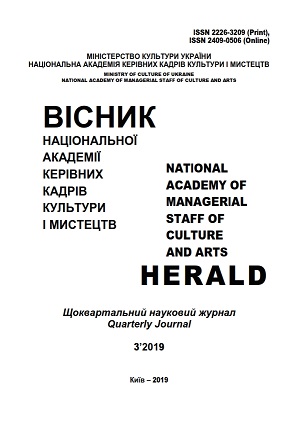Поетика вокального циклу П. Хіндеміта «Житіє Марії» в руслі духовних і стильових шукань німецької культури і музики першої половини ХХ століття
The Poetics of the Vocal Cycle of P. Hindemith «Life of Mary» in the Context of the Spiritual and Stylistic Quest of German Culture and Music of the First Half of the Twentieth Century
Author(s): Olga Viktorivna MuravskayaSubject(s): Cultural history, Music, Aesthetics, Recent History (1900 till today), History of Art
Published by: Національна академія керівних кадрів культури і мистецтв
Keywords: chamber-vocal cycle; works by P. Hindemith; vocal cycle «Life of Mary»; German musical neo-classicism;
Summary/Abstract: The purpose of the article is to identify the poetic-intonational uniqueness of the P. Hindemith‘s cycle ―The Life of Mary‖ in the context of the religious and aesthetic attitudes of the composer‘s work and the spiritual and stylistic specificity of German culture of the first half of the 20th century. The methodology of the work is based on the cultural-historical approach in musicology; inherited from B. Asafiev and his followers, as well as on interdisciplinary, etymological and historical-culturological approaches. The scientific novelty of the work is determined by the fact that the mentioned cycle of P. Hindemith is first considered in Ukrainian musicology and art history from the perspective of not only the spiritual and creative position of the composer but also the evolutionary paths of the vocal cycle in the German cultural, historical and musical traditions of the XIX-XX centuries. Conclusions. For P. Hindemith, the emergence of the «Life of Mary» cycle is connected not only with the transition to neoclassicism positions, but also with an interest in the specifics of the so-called «new spirituality» or «new religiosity» essential for the culture of the entire twentieth century. For the cycle, genre synthesis is indicative, bringing it closer to mono-opera and the German spiritual cantata. This cycle is also characterized by equality of vocal and instrumental parts as components of a single polyphonic whole at the level of «contrapuntal unity». Polyphonism as defining the texture-style quality of the «Life of Mary» cycle is manifested in the extensive use of basso ostinato, fugato, canons, and methods of contrasting polyphony, which demonstrate the dominance of the linear principle and determine the neoclassical style of this work. The latter is also revealed through the rhetorical-semantic aspects of the Baroque forms and the symbolic-allegorical interpretation of tonalities.
Journal: Вісник Національної академії керівних кадрів культури і мистецтв
- Issue Year: 2019
- Issue No: 3
- Page Range: 161-166
- Page Count: 6
- Language: Ukrainian

